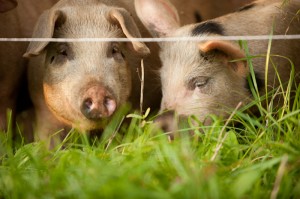 ‘Tis the season – for pork, that is. Still following a tradition of starting piglets in the spring and early summer (raising them through the warm months, and finishing or fattening them on the abundance of fall), many local Adirondack farmers are now harvesting and selling their hogs for pork, ourselves included. Now is one of the best times for consumers to fill their freezer with a whole of half hog, raised and butchered as they like. Probably no surprise here, but half of those hogs are female, half male. And of those males, probably most are castrated. But our male pigs are not.
‘Tis the season – for pork, that is. Still following a tradition of starting piglets in the spring and early summer (raising them through the warm months, and finishing or fattening them on the abundance of fall), many local Adirondack farmers are now harvesting and selling their hogs for pork, ourselves included. Now is one of the best times for consumers to fill their freezer with a whole of half hog, raised and butchered as they like. Probably no surprise here, but half of those hogs are female, half male. And of those males, probably most are castrated. But our male pigs are not.
If you find yourself asking “so?” then you probably aren’t familiar with “boar taint.” When we first started raising pigs, anyone with even third-hand hog-raising experience would tell us “you can’t eat a boar!”, adding that “it’ll taste like [I kid you not] piss” or other choice words. Why? The male hormones produced by a boar can make the meat taste so foul and rank as to make it virtually inedible. Hence the long-standing practice of castrating male piglets – making a cut into either side of the scrotum, pulling out the testicles and cutting them off and out. This transforms the “boar” into a “barrow” (the bull/steer distinction of the porcine world). Plus, many say, barrows grow faster than boars.
As it turns out, taint ain’t so simple. (Taint/t’ain’t – nice wordplay, right?)
Yes, boar taint is real, and when present, it makes the meat smell and taste awful: about 75% of consumers can detect and taste boar taint (meaning 25% of you all are off the hook though!), but 75% is a pretty good reason to eliminate taint one’s pork. Hence castration (usually physical, but sometimes chemical/hormonal).
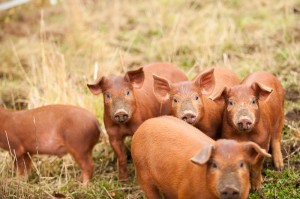 However, hold the scalpel: taint is present in only about 20% of boars and male pigs. This means 80% of male pigs are being castrated unnecessarily. Taint is also differentially present according to breeds: Durocs seem to have the highest levels if incidence, while lighter colored breeds like Landrace and Yorkshire have it less. This is the genetic basis to boar taint. There are also management factors, which have to do with what causes taint. Why should we care? (This is the $64,000 question after all.) I’ll get to that.
However, hold the scalpel: taint is present in only about 20% of boars and male pigs. This means 80% of male pigs are being castrated unnecessarily. Taint is also differentially present according to breeds: Durocs seem to have the highest levels if incidence, while lighter colored breeds like Landrace and Yorkshire have it less. This is the genetic basis to boar taint. There are also management factors, which have to do with what causes taint. Why should we care? (This is the $64,000 question after all.) I’ll get to that.
So what are the causes of boar taint? Two compounds which can be deposited in the fat of growing pigs can cause the off-smells and flavors in the meat (really just the fat) down the the road. One is androstenone, a pheromone produced in the testes, but also the adrenal glands; the other is skatole, produced by bacteria in the intestines. These can be chemically (objectively) measured, in addition to being tasted by many (a subjective measure).
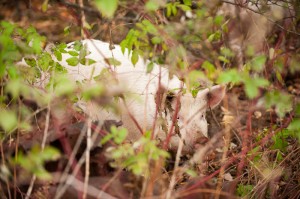 Regarding skatole, and noticing the root of the word, “skat-”, clues you in that this has to do with feces. Skatole can be produced from pigs inhaling or ingesting their own feces, which is prone to happen with pigs raised in cramped conditions. Turns out, raising hogs on pasture virtually eliminates the risk from skatole taint, a combination of having more space as well as access to high-fiber vegetation. Even after just two weeks on pasture, a hog previously with skatole will no longer have it afterward. While skatole can be present in barrows and gilts (female pigs) as well as boars, steroids produced by the boar inhibit the breakdown of skatole, so they accumulate more of it. Hence castration reducing this taint factor.
Regarding skatole, and noticing the root of the word, “skat-”, clues you in that this has to do with feces. Skatole can be produced from pigs inhaling or ingesting their own feces, which is prone to happen with pigs raised in cramped conditions. Turns out, raising hogs on pasture virtually eliminates the risk from skatole taint, a combination of having more space as well as access to high-fiber vegetation. Even after just two weeks on pasture, a hog previously with skatole will no longer have it afterward. While skatole can be present in barrows and gilts (female pigs) as well as boars, steroids produced by the boar inhibit the breakdown of skatole, so they accumulate more of it. Hence castration reducing this taint factor.
Androstenone is produced by the boar’s testes, a pheromone with a urine-like odor, which can be deposited in the fat as the boar matures. This factor in boar taint seems to be less effected or controlled by management and diet, and simply more linked to genetics and sexual development. So, again, typically castration to the rescue.
We’ve steadily been harvesting boars here on our farm, and thus far have had no complaints. Did we luck out? Some advice for minimizing the risk of boar taint is to harvest at 6-7 months of age, or under 200 to 225 pounds live. Our first set of hogs that we brought to the USDA processor were more like 8-9 months old, and their hanging weights were 220, 200, 190, and 175 pounds (the formers two being the uncut males from the bunch, the latter two the females). Add 40-50% to those numbers for the live weights. This means that those 220 and 200 pounds hanging-weight males were around 300 pounds live – a pretty far cry from the recommendation of 220-pound slaughtering. They also lived with the females, and being raised over the winter, (unfortunately) did not receive as much pasture forage as we would have liked – only in the first few months and then again the last month-and-a-half or so of their lives. But they did get some whey over the winter, which reputedly helps as well.
There were originally 5 pigs in the bunch, and one of them, also a male, who refused to get on board the trailer come slaughtering day appointed himself the hog for our June pig roast. This means this boar grew another month and a half, getting bigger and older to around 10 months of age, and quite heavy indeed! But that was also more time on pasture, pretty much alone (there were some weaners next to him), and he ended up getting a lot of whey and milk to eat/drink.
Presumably their genetics played a role too. These pigs were roughly half Large Black, half Tamworth, with a smidgeon of Hampshire in there I think. We’ve also butchered a Yorkshire boar and a Tamworth-something boar in the past which have turned out find as well. The stars of genetics, management, and feed all aligning? Most recently, a 3/4 Large Black 1/4 Tamworth boar went to the freezer, taintless again. This one was also big, hanging at 200lbs and around 8.5 months old. Most surprising, though, was that we later learned this fellow was in fact sexually active (a bit of brotherly love with his sisters…), as one of his sisters which went to the butcher a month later turned out to be well along in pregnancy, meaning at around 6 months old there was breeding going on.
But if we are playing Russian Roulette each time we raise a boar, why do it? Why not just castrate? Most obvious is the humaneness issue – not castrating avoids a stressful and painful procedure for male piglets, usually done by the farmer rather than a vet with the use of anesthetic. Of course, ethical issues like humane treatment can be a good if not central selling/buying point for many consumers.
Which leads to economic reasons as well. Castration takes time for the farmer. And if the cut gets infected, this could require medical treatment, setback in weight gains, or even death for the pig. Plus, it turns out (studies attest, in one form or another), barrows actually grow slower than boars, and/or require more feed to reach the same weight (i.e. barrows are are less efficient growers). Plus, compared to boars, pound for pound barrows are fattier, while boars are leaner and thus have more muscle, more meat. (They also tend to be longer, and – pop quiz – longer hogs mean what (proportionally)? That’s right, more bacon!) Finally, for anyone raising their own breeding pigs, not castrating males gives you a pool to pick potential breeders from; castration closes that door early on.
Presumably we are doing something right with out management (e.g. housing and diet) – something which others interested in raising boars can do as well – we can continue these practices, but genetics are less easily controlled. It highlights the need to continue to source feeder piglets from sources that have proven not to present boar taint in the past (i.e. in slaughtered boars), and/or to continue raising our own from established taint-free lines. It is also possible, when or if bringing in new blood, to have that boar tested while live, through a blood test (which can chemically measure the levels of androstenone and skatole present, and correlate to the levels detected by smell and taste) or even, as Walter Jeffries has done (http://sugarmtnfarm.com/2012/
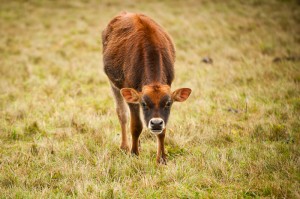 In researching and writing this, I did get to thinking – if we can get by without castrating boars, can we do the same for bulls (and rams or bucks, if we raised those)? The answer here seems: maybe. The good news is that rams and bulls are even less likely to have off-tasting meat than are boars. There’s also a different procedure available to castrate a ruminant – they can be non-surgically banded. Or if using surgery (for a bull), it can be easier to justify, economically, having a vet perform it, with anesthesia, since the cost of that procedure applied to a bull calf will be spread out over many more pounds of meat in the end (anywhere from 5 to 10 times that of a pig; this is what we’ve done with our bull calves to date).
In researching and writing this, I did get to thinking – if we can get by without castrating boars, can we do the same for bulls (and rams or bucks, if we raised those)? The answer here seems: maybe. The good news is that rams and bulls are even less likely to have off-tasting meat than are boars. There’s also a different procedure available to castrate a ruminant – they can be non-surgically banded. Or if using surgery (for a bull), it can be easier to justify, economically, having a vet perform it, with anesthesia, since the cost of that procedure applied to a bull calf will be spread out over many more pounds of meat in the end (anywhere from 5 to 10 times that of a pig; this is what we’ve done with our bull calves to date).
The exception to the male-taste issue may be a ram during rut, the breeding season when hormones run high (or a goat buck, which can stink to high heaven). But there are management issues too. Consider lamb: typically born in the spring, they could grow and finish on grass through the summer and be butchered in the fall, on the smallish size. However, if you want lamb on the larger end, you need to keep them through winter. But then you only have a couple months in the spring before the rut starts later in summer, so its not really worth holding over the winter if you only get a bit of grazing in before the rut. So making a ram lamb into a wether provides more flexibility for slaughtering times (if rut-flavoring holds true). But for fall-finishing spring-born lambs, castration is not necessary.
Bulls also present a management issue, but not so much regards breeding directly – rather, bulls can be dangerous, and they can start being so well before fully grown where you’d want to harvest them. There’s a truthful adage to “never turn your back on a bull” – never mind a whole herd of them. A 200-300 pound possibly aggressive young boar is one thing; a 1500-2500+ pound bull is quite another (I imagine Kristen Kimball at Essex Farm would agree, from reading her The Dirty Life…). But there are benefits as well, like leaner meat in bulls compared to steers and faster or more efficient rate of growth. I would suspect that temperament is heritable, so perhaps one could select more for docile bulls (but friendly, docile bulls are also known to be closet aggressives, surprising you when you don’t expect it!). So will we ever raise bulls for beef? I can’t yet say.
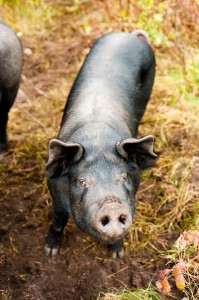 In the meantime, we’ll continue to raise – and promote – boars destined for pork, and if you join us in that, more (bacon) power to ya’!
In the meantime, we’ll continue to raise – and promote – boars destined for pork, and if you join us in that, more (bacon) power to ya’!

Thank you!!! This helped me so much! I am getting a gilt this Saturday and a boar will be delivered to us on Friday. I plan to breed these pigs when they reach sexual maturity. I have been doing a lot of research and came across the issue of “boar taint.” I looked up how to castrate a piglet and I COULD NOT STAND seeing it. I could’t finish the video for two reasons, one: It looked very painful for the poor piglets without the anesthesia, and two, i cannot stand the site of blood… every where I have looked everyone has been dismissing the idea of not castrating the male piglets when keeping them for meat, and completely just thinking the idea is unreasonable, and even stupid. But I am very happy I came across your article! Lots of facts and statistics and frankly, common sense. And by the way… I LOVE BACON!!!
The number ONE reason for castration is to prevent unwanted matings; either for management purposes (such as being able to run gilts and barrows, or steers and heifers together)- and/or to prevent lower quality males from reproducing. The fact that castrated males are more docile, less likely to challenge fencing – or humans – is another important advantage of castration.
Selecting for good temperament, along with other economically important traits (which may vary, of course, depending on the market, the management system, etc)
si well worth doing, and temperament does appear to be highly heritable. That said, to toss castration as a management tool – as the EU has promised to do by 2018 – out of well-intended anthropomorphism, is rash.
BTW, the meat of goat bucks slaughtered during the rut does not necessarily have an ‘off’ or ‘goaty’ flavor, if care is taken during the process to not contaminate the meat with the excretions from the scent glands. Ram meat is not an issue, either. (However, adult sheep from breeds with heavier lanolin do tend to have more of a ‘muttion’ flavor that Americans find unpalatable.)
While rams, bucks, and bulls can be banded, they recover more quickly if they are simply cut – if the equipment is sharp and the technique is good. This runs counter to our human tendancy to project our imaginings and preconvieved notions onto ther world, especially animals, but both observation and studies have shown this to be true.
All that aside, both options should remain open to the animal husbandrist.
My Husband won a pig as in Meat in the Spring of 2015. I have not noticed issues with Ham but the ground Sausage and Bacon has smell and taste that is not terrible but not great. I have tried to spice up the sausage and it worked was too saltly and just not good anyway, but it still has the “smell”. So is there anything I can do to this meat to still use it and get rid of the smell. I never knew about boar meat until my friend who’s Dad is a Farmer told me that this is why the meat smells different. It just a shame to throw it all out but if I can’t get rid of the smell and taste, then its useless.
Thanks for your help and your website is very interesting.We live in Michigan.
I grew up on a hog farm where all of our males were quickly and efficiently castrated at 2 or 3 days. The meat was much better than anything you buy today.
I stopped buying pork bc of the taint. I am so frustrated at the pervasive taint taste that I looked it up to see if I was going crazy bc I taste it every time I try pork.
Frankly, it is far more humane to castrate a piglet than to circumcise a baby boy. A quick slip of a sharp razor blade, a couple stiff steps by the piglet and no problems. PETA, EU and the rest of the “humane” champions should care about people instead of sticking their noses in pork industry business.
Farrowing stalls are fine for sows for the short time they are used on family farm operations and I have read “horror” stories about them too.
Vaccines make drug companies money, castration doesn’t. Seems to me that is all we need to know on this issue.